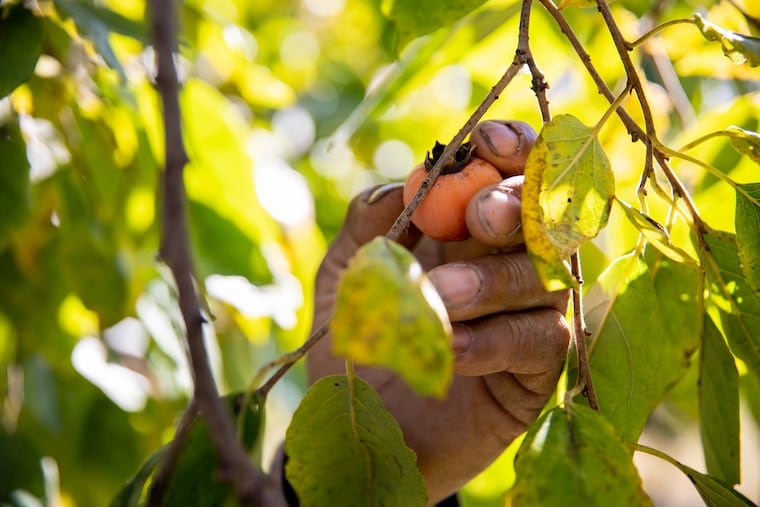Caramel-sweet and elusive, American persimmons are at their ripest. Here’s where to eat them in Philly.
Persimmon season can span mid-September through December, but to try one yourself, you'll have to go foraging — or to a few choice restaurants.

With its green spaces and historic foodways, Philadelphia has its share of unique fruits you can’t find in the grocery store. Purple-blue juneberries, snackable from neighborhood street trees, usher in their namesake month, while ripe pawpaws and their creamy golden flesh signal the transition from summer to fall.
But there’s another elusive tree fruit you’ve probably never tasted, though it grows throughout the Mid-Atlantic — found on trees in West Philly, Germantown, and East Fairmount Park.
Meet the American persimmon, botanical name Diospyros virginiana, or “food of the gods,” and the largest berry in the world. The flavor of these silver dollar-sized fruits is syrupy-sweet and complex, with a thick, jammy texture, almost as if the flesh inside had been concentrated into a caramel. (While they have pumpkin-colored skin like their more commercially available Asian relatives, seedless fuyu and hachiya persimmons, American persimmons are smaller, with a higher sugar content.)
“They’re one of our easiest-to-grow fruits,” says Phil Forsyth, executive director of the Philadelphia Orchard Project, a nonprofit that plants and supports dozens of community orchards across the city. “No pest or disease problems whatsoever, and you tend to have a consistent harvest year to year … and they’re very tasty when they are ripe.”
“Ripe” is key here: The delicate, highly perishable fruits are ready to eat only when their flesh is water balloon-soft beneath their thin, wrinkled skins — try one before that, and you’ll get a bitter, astringent mouthful.
The surest way to know that an American persimmon is ripe? Simply wait for it to drop off the tree. The fruits ripen all autumn long, which means that daily yields can be small, but also that persimmon season can span mid-September to December.
Because of its delicate nature and small, incremental harvests, American persimmons aren’t cultivated commercially. To try one for yourself, you might have to go on a foraging expedition (with permission, of course).
Or treat yourself to a nice dinner: Fork in Old City, Terrain in Devon, and the Inn at Grace Winery in Glen Mills are showcasing American persimmons on their autumn menus, as is Andiario in West Chester.
Chef-owner Anthony Andiario highlights the fruit as he would its summer-berry cousins. Perfectly ripe persimmons are served whole, seeds and all, alongside locally raised trout grilled over juniper branches. Follow it with a dessert of persimmon gelato, accompanied by gingerbread wafers.
“The gelato is fantastic — a true expression of what a persimmon is,” Andiario says. “It keeps that unique texture of the persimmon and that mouthfeel.”
The chef preserves persimmons by making a loose jam, running the sugary fruits through a sieve to capture the pulp. He soaks the skins and seeds in white wine vinegar until they impart their flavor. The infused vinegar and the jam are combined with mustard seeds and mustard oil to make a tangy-spicy-sweet mostarda.
Heating persimmon pulp in most cases brings back its tannic, pre-ripe quality, but exceptions to that rule are baked goods like the persimmon cake at Andiario, which has a dense, almost custard-like texture and rich, caramel flavor.
Baking has been a long-practiced use for persimmons, which served as a rare source of sweetness in precolonial America. In the Mid-Atlantic, Midwest, and South — the fruit’s native habitats — indigenous people used them to make puddings and soups, and dried them for winters. When European colonizers arrived, they adopted the method of baking persimmons into puddings, while enslaved Africans across the South foraged them to eat fresh and ferment into beer.
Though native persimmon trees are time-tested and highly adaptable, there are reasons they aren’t more prevalent. Besides their finicky ripening process, they can reach 60 feet at maturity, and wild varieties need both male and female trees to fruit — not exactly ideal for a street corner or postage-stamp backyard. And ripe fruits are too delicate and high-maintenance for all but the most dedicated foragers to sell commercially.
But Max Paschall, a certified arborist and program assistant with TreePhilly, the city’s urban forestry program, believes that sugary American persimmons can play an important role in Philadelphia’s food future. Climate models project that Southeast Pennsylvania will become as hot and humid as Florida in the next 50 years.
“The crops that we need to be growing are the crops that are actually resilient, that don't need sprays, that need minimal maintenance,” Paschall says. “We need to find tree crops like this and bring them back into our cuisine.”
Native persimmons can survive sweltering heat and cold snaps, so Paschall believes that they’re essential to plant for climate resilience.
After all, he says, “There’s nothing better than coming outside and having a huge harvest of one of the best-tasting fruits in the world every year.”